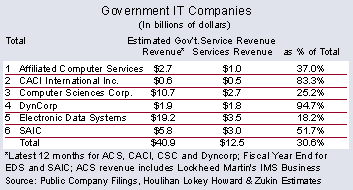MARKET WATCH
Increasingly, the major players in federal information technology and defense technology services, or government tech services, are the aerospace and defense primes.
Increasingly, the major players in federal information technology and defense technology services, or government tech services, are the aerospace and defense primes. Six of the largest domestic companies ? Lockheed Martin Corp., Northrop Grumman Corp., General Dynamics Corp., Raytheon Co., United Technologies and TRW Inc. ? generate approximately $20 billion in annual services revenue, of which an estimated 70 percent to 75 percent is derived from government markets. This government services component represents about 15 percent of revenue for this group, and roughly one-third of its collective $50 billion defense market revenue. Compare this aggregate government services element with six of the major technical services companies in the government market: Affiliated Computer Services Inc., Electronic Data Systems Corp., Computer Sciences Corp., Science Applications International Corp., DynCorp and CACI International Inc. These companies produce government services revenue in the range of $12 billion to $14 billion out of total revenue of approximately $40 billion. This is 30 percent to 35 percent of total revenue.Based upon these estimates, the six aerospace and defense primes have greater government services revenue then the six technical services providers. The increased presence of major aerospace and defense primes in the government services sector reflects industry trends, current and projected. Most significant among these trends are: ? The emergence of systems integration of off-the-shelf components in place of milspec manufacturing; ? Continuing emphasis by the Defense Department on deploying high technology in all phases of defense and intelligence activity; ? Sluggish demand for major weapons platforms, such as planes, ships and armored vehicles; ? Full life-cycle support as a critical customer requirement; ? The interplay of emerging complex technologies with support services requirements beyond government user capability, adding to the momentum of outsourcing and privatization.While there are other factors involved, such as contract bundling, these attributes of the market are most important.During the past decade, remarkable progress in computer and communication technologies has revolutionized information gathering, processing and distribution. Most of these technology upgrades have been produced in the private sector and, subsequently, incorporated into products designed for commercial and consumer markets. Analysts estimate that non-government research and development expenditures are five to seven times the level of R&D spending for government and defense markets. Accordingly, it is essential that companies serving defense markets fully leverage commercial R&D when designing and building products for defense markets.By nature, many government technical service companies have developed and applied the skills necessary to succeed in systems integration work. In addition, these service companies are populated by thousands of experienced analysts, logisticians, program managers and other technical support personnel who understand the defense domain. Increasingly, Defense Department customers want to buy products and support services in one integrated package, a "life-cycle support" concept. The typical technical support services components include installation, testing, training, maintenance, spares, field upgrade and modifications. In this context, the imperative for aerospace and defense primes to build and buy technical services components is very clear.Recent remarks by senior defense officials further underline the growing importance of technical services in the government sector. Defense Department priorities incorporate several objectives:? Rationalize weapons systems and infrastructure with strategy; ? Improve the health of the defense industrial base through improved profits and cash flows and government sharing of cost savings with contractors; ? Streamline acquisition and logistics functions through training upgrades and revitalization of morale; ? Continue emphasizing high-level technology, including raising the science and technology budget to a level of 3 percent or more of total Defense Department spending.Taken together, these market factors and trends provide a context for continuing growth in government services activity relative to total government and defense spending. Considering overall economic sluggishness along with the terrorist actions of Sept. 11, the government and defense services sector should attract increased attention and investment. Merger and acquisition activity, along with private capital investment, in the industry is likely to increase as well.



Jerry Grossman is managing director at Houlihan Lokey Howard & Zukin in McLean, Va.

Jerry Grossman


Jerry Grossman is managing director at Houlihan Lokey Howard & Zukin in McLean, Va.
NEXT STORY: HP-Compaq Merger Could Aid Resellers

